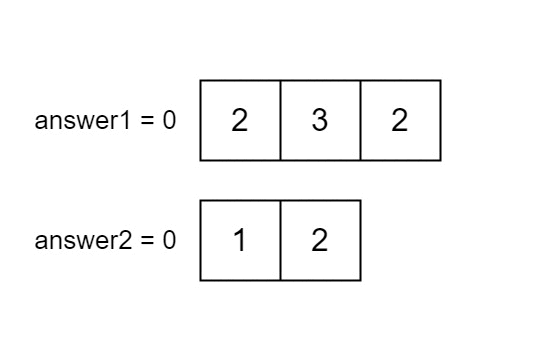| comments | difficulty | edit_url | rating | source | tags | ||
|---|---|---|---|---|---|---|---|
true |
Easy |
1214 |
Biweekly Contest 119 Q1 |
|
You are given two integer arrays nums1 and nums2 of sizes n and m, respectively. Calculate the following values:
answer1: the number of indicesisuch thatnums1[i]exists innums2.answer2: the number of indicesisuch thatnums2[i]exists innums1.
Return [answer1,answer2].
Example 1:
Example 2:
Input: nums1 = [4,3,2,3,1], nums2 = [2,2,5,2,3,6]
Output: [3,4]
Explanation:
The elements at indices 1, 2, and 3 in nums1 exist in nums2 as well. So answer1 is 3.
The elements at indices 0, 1, 3, and 4 in nums2 exist in nums1. So answer2 is 4.
Example 3:
Input: nums1 = [3,4,2,3], nums2 = [1,5]
Output: [0,0]
Explanation:
No numbers are common between nums1 and nums2, so answer is [0,0].
Constraints:
n == nums1.lengthm == nums2.length1 <= n, m <= 1001 <= nums1[i], nums2[i] <= 100
We can use two hash tables or arrays
Next, we create an array
Then, we traverse each element
Finally, we return the array
The time complexity is
class Solution:
def findIntersectionValues(self, nums1: List[int], nums2: List[int]) -> List[int]:
s1, s2 = set(nums1), set(nums2)
return [sum(x in s2 for x in nums1), sum(x in s1 for x in nums2)]class Solution {
public int[] findIntersectionValues(int[] nums1, int[] nums2) {
int[] s1 = new int[101];
int[] s2 = new int[101];
for (int x : nums1) {
s1[x] = 1;
}
for (int x : nums2) {
s2[x] = 1;
}
int[] ans = new int[2];
for (int x : nums1) {
ans[0] += s2[x];
}
for (int x : nums2) {
ans[1] += s1[x];
}
return ans;
}
}class Solution {
public:
vector<int> findIntersectionValues(vector<int>& nums1, vector<int>& nums2) {
int s1[101]{};
int s2[101]{};
for (int& x : nums1) {
s1[x] = 1;
}
for (int& x : nums2) {
s2[x] = 1;
}
vector<int> ans(2);
for (int& x : nums1) {
ans[0] += s2[x];
}
for (int& x : nums2) {
ans[1] += s1[x];
}
return ans;
}
};func findIntersectionValues(nums1 []int, nums2 []int) []int {
s1 := [101]int{}
s2 := [101]int{}
for _, x := range nums1 {
s1[x] = 1
}
for _, x := range nums2 {
s2[x] = 1
}
ans := make([]int, 2)
for _, x := range nums1 {
ans[0] += s2[x]
}
for _, x := range nums2 {
ans[1] += s1[x]
}
return ans
}function findIntersectionValues(nums1: number[], nums2: number[]): number[] {
const s1: number[] = Array(101).fill(0);
const s2: number[] = Array(101).fill(0);
for (const x of nums1) {
s1[x] = 1;
}
for (const x of nums2) {
s2[x] = 1;
}
const ans: number[] = Array(2).fill(0);
for (const x of nums1) {
ans[0] += s2[x];
}
for (const x of nums2) {
ans[1] += s1[x];
}
return ans;
}